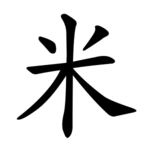
Summary
Radical 119 or radical rice (米部) meaning "rice" is one of the 29 Kangxi radicals (214 radicals in total) composed of 6 strokes.
| 米 | ||
|---|---|---|
| ||
| 米 (U+7C73) "rice" | ||
| Pronunciations | ||
| Pinyin: | mǐ | |
| Bopomofo: | ㄇㄧˇ | |
| Gwoyeu Romatzyh: | mii | |
| Wade–Giles: | mi3 | |
| Cantonese Yale: | máih | |
| Jyutping: | mai5 | |
| Japanese Kana: | ベイ bei / マイ mai (on'yomi) こめ kome (kun'yomi) | |
| Sino-Korean: | 미 mi | |
| Names | ||
| Chinese name(s): | (Left) 米字旁 mǐzìpáng (Bottom) 米字底 mǐzìdǐ | |
| Japanese name(s): | 米/こめ kome (Left) 米偏/こめへん komehen | |
| Hangul: | 쌀 ssal | |
| Stroke order animation | ||
 | ||

In the Kangxi Dictionary, there are 318 characters (out of 49,030) to be found under this radical.
米 is also the 144th indexing component in the Table of Indexing Chinese Character Components predominantly adopted by Simplified Chinese dictionaries published in mainland China.
Evolution edit
-
Oracle bone script character
-
Bronze script character
-
Large seal script character
-
Small seal script character
Derived characters edit
| Strokes | Characters |
|---|---|
| +0 | 米 |
| +2 | 籴SC (=糴) 籵 (=蹯 -> 足) 籶 |
| +3 | 娄SC (=婁) 籷 籸 籹 籺 类SC (=類) 籼SC (=秈) 籽 籾 籿 粀 粁 粂 |
| +4 | 粃 (=秕 -> 禾 / 紕 -> 糸) 粄 粅 粆 粇 (=糠/粳) 粈 粉 粊 粋JP (=粹) 粌 粍 粎 粏 粐 粑 |
| +5 | 畨 (=翻 -> 羽 / 番 -> 田) 粒 粓 粔 粕 粖 粗 粘 粙 粚 粛JP (=肅 -> 聿) 粜SC (=糶) 粝SC (=糲) 粣 |
| +6 | 粞 粟 粠 粡 粢 粤SC/JP (=粵) 粥 粦 粧 (=妝 -> 女) 粨 粩 粪SC (=糞) 粫 粬 (=麴 -> 麥) 粭 |
| +7 | 粮SC (=糧) 粯 粰 粱 粲 粳 粴 粵 糀 |
| +8 | 粶 粷 粸 粹 粺 (=稗 -> 禾) 粻 粼 粽 精 粿 糁SC (=糝) |
| +9 | 糂 (=糝) 糃 糄 糅 糆 糇SC (=餱) 糈 糉 (=粽) 糊 糋 糌 糍 糎 |
| +10 | 糏 糐 糑 糒 糓 糔 糕 糖 糗 糘 |
| +11 | 糙 糚 糛 (=糖) 糜 糝 糞 糟 糠 糡 糢 糨 |
| +12 | 糣 糤 (=饊 -> 食) 糥 糦 糧 |
| +13 | 糩 糪 糫 糬 糭 (=粽) |
| +14 | 糮 糯 糰 |
| +15 | 糲 |
| +16 | 糱 糳 糴 |
| +17 | 糵 (=糱) |
| +19 | 糶 |
| +21 | 糷 |
Variant forms edit
This radical character has a different form in Taiwan Traditional Chinese to in other writing systems.
Traditionally, the two diagonal strokes under the horizontal start from the central junction, and the last stroke is a right-falling press when the character appears independently or a dot when used as a component. In Taiwan's Standard Form of National Characters, however, all four diagonal strokes are detached from other strokes, and the last stroke is a dot, whether used independently or as a component.
| Traditional | Taiwan |
|---|---|
| 米 粒 | 米 粒 |
Sinogram edit
The radical is also used as an independent Chinese character. It is one of the Kyōiku kanji or Kanji taught in elementary school in Japan.[1] It is a second grade kanji[1]
References edit
Literature edit
- Fazzioli, Edoardo (1987). Chinese calligraphy : from pictograph to ideogram : the history of 214 essential Chinese/Japanese characters. calligraphy by Rebecca Hon Ko. New York: Abbeville Press. ISBN 0-89659-774-1.
- Lunde, Ken (Jan 5, 2009). "Appendix J: Japanese Character Sets" (PDF). CJKV Information Processing: Chinese, Japanese, Korean & Vietnamese Computing (Second ed.). Sebastopol, Calif.: O'Reilly Media. ISBN 978-0-596-51447-1.
External links edit
- Unihan Database - U+7C73


